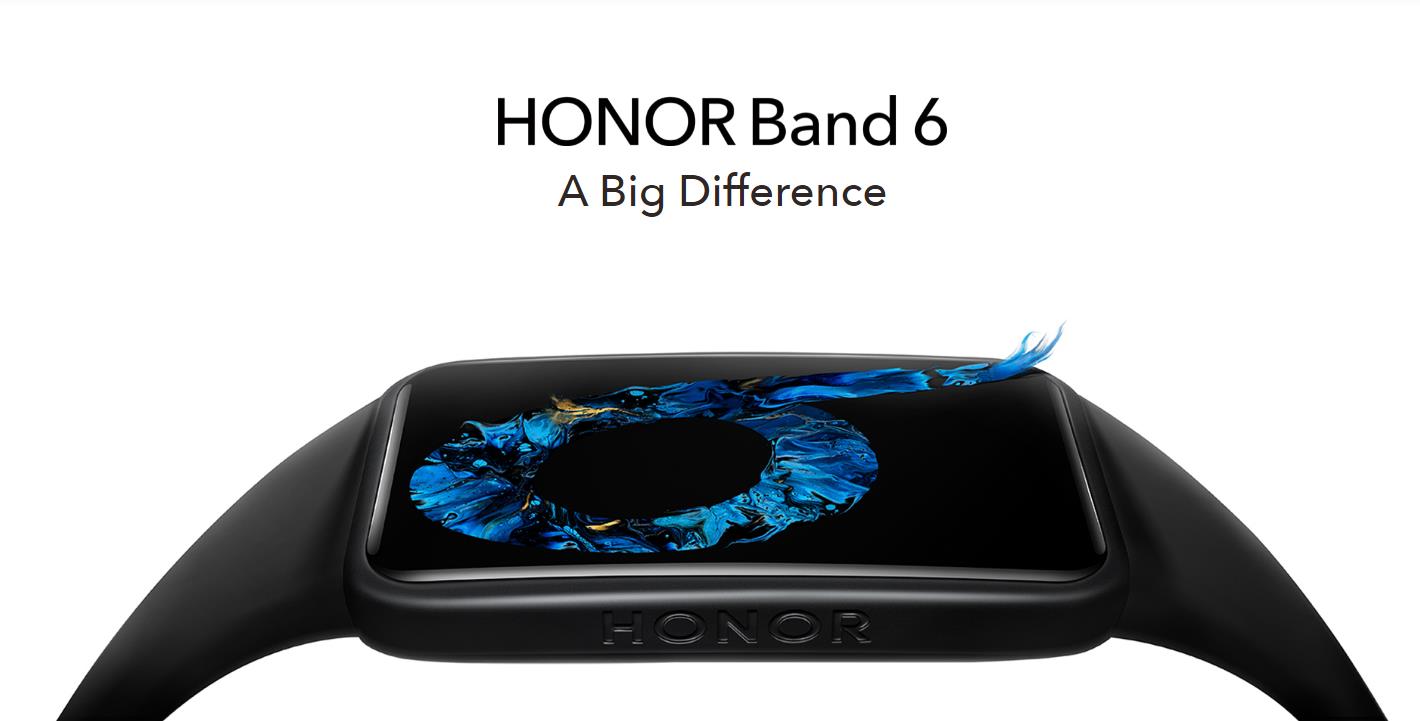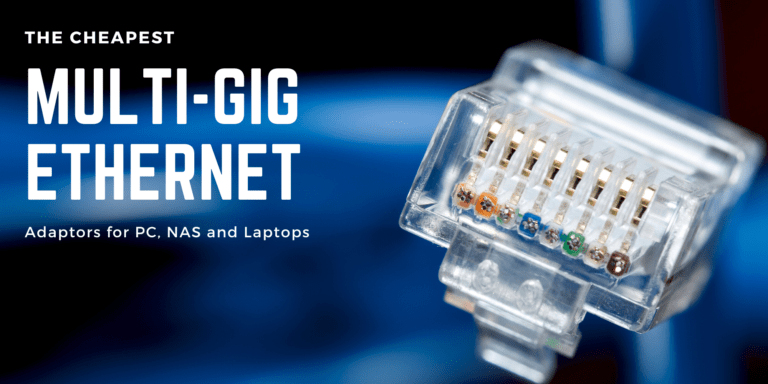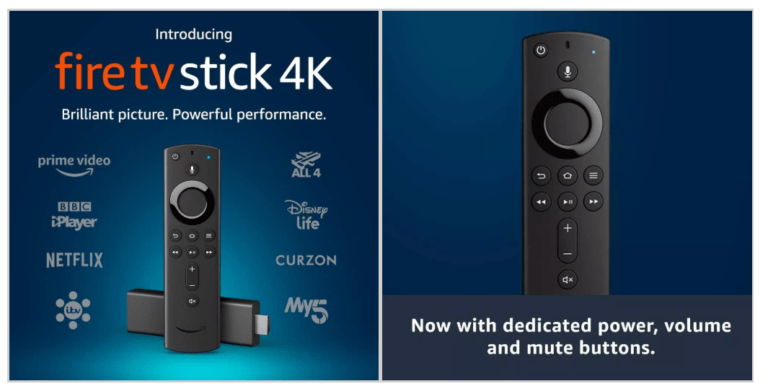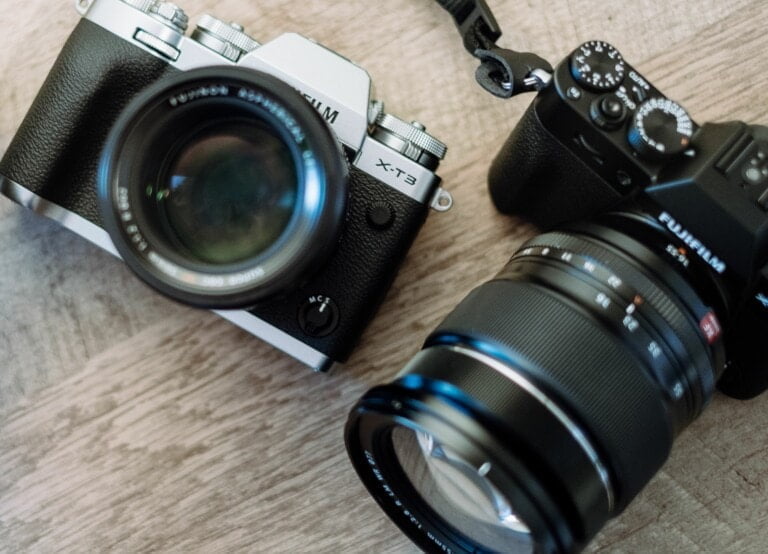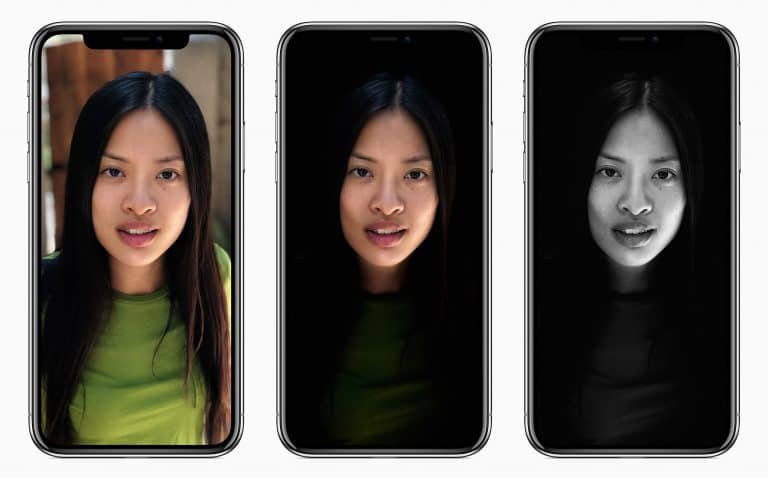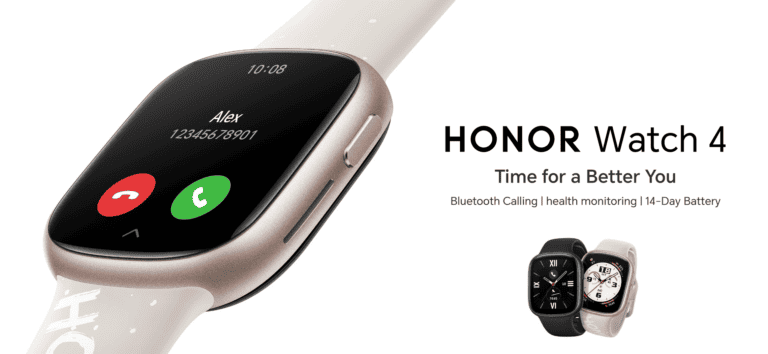Any links to online stores should be assumed to be affiliates. The company or PR agency provides all or most review samples. They have no control over my content, and I provide my honest opinion.
The Honor Band 6 was announced for a global launch in January. I have been informed there is no official launch price or date yet, even though it has literally been on Amazon since mid-April for £44.99.
Not much has changed since the Honor Band 5, but it is still one of the best entry-level wearables on the market.
Specification
| Preview | Product | Rating | Price | |
|---|---|---|---|---|

| HONOR Band 6 Fitness Tracker Smart Watch,1.47" AMOLED Color... | Buy on Amazon |
- 1.47″ AMOLED screen
- 14 days battery life (10 days heavy usage)
- Blood oxygen level monitor
- Intelligent 24-Hour heart rate monitor
- 10 Professional workout modes
- Watch face customisation to fit your mood
- Sleep tracking
- Stress tracking
- All day heart rate
- Manual blood oxygen tests
- Female cycle tracker
- Uses your phone GPS
Honor Band 6 vs Honor Band 5 vs Huawei Band 6
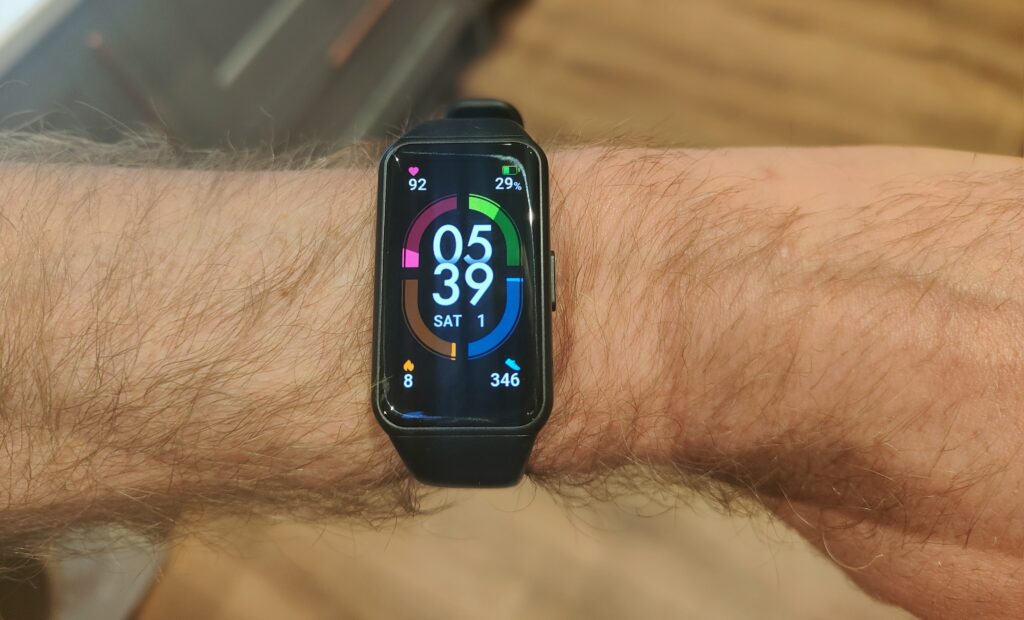
| Honor Band 6 | Honor Band 5 | Huawei Band 6 | |
| Display | 1.47-inch AMOLED | 0.95-inch AMOLED | 1.47 inch AMOLED |
| Up to 282 PPI | Up to 282 PPI | ||
| 194 x 368 pixels | 240 x 120 pixels | 194 x 368 pixels | |
| 2.5D Curved Glass | 2.5D Curved Glass | ||
| Connectivity | Bluetooth 5.0 BLE | Bluetooth 5.0 BLE | 2.4 GHz, BT5.0, BLE |
| GPS | No | No | |
| Sensors | Heart rate sensor (optical) | Heart rate sensor (optical) | Accelerometer sensor |
| Spo2 sensor (optical) | Spo2 sensor (optical) | Spo2 sensor (optical) | |
| 3-Axis Accelerometer | 3-Axis Accelerometer | Optical heart rate sensor | |
| Gyroscope | Gyroscope | Gyroscope sensor | |
| Sleep Monitor | Sleep Monitor | Sleep Monitor | |
| Battery | 14 Days of Standby Time on a Single Charge | 14 Days of Standby Time on a Single Charge | 14 days for typical use |
| NFC | No (Global) | No (Global) | |
| Water Resistance | 5ATM or 50m | 5ATM or 50m | 5ATM or 50m |
| Features | 10 workout types | 10 workout types | 11 workout types |
| General health and sleep tracking | General health and sleep tracking | General health and sleep tracking | |
| Notifications | Notifications | Notifications | |
| Music playback controls | Music playback controls | Music playback controls | |
| Stopwatch | Stopwatch | Stopwatch | |
| Alarm | Alarm | Alarm | |
| Camera shutter | Camera shutter | Camera shutter | |
| Find My Phone | Find My Phone | Find My Phone | |
| Compatibility | Android, iPhone | Android, iPhone | |
| Size | 43 × 25.4 × 11.45mm | 43 x 25.4 x 10.99 mm | |
| Weight | 18g | ||
| Materials | Polycarbonate/Silicone | Polycarbonate/Silicone | |
| Price | £45 | £35 | £60 |
Honor may be completely independent of Huawei now, but with the recent wearables, they still share much of the same technology. There seems to be a couple of differences which help justify the higher RRP of the Huawei. There is all-day SPO2 tracking, which I think is much more useful than one-off checks. It is also listed as having 2.4 GHz connectivity, so I assume WiFi.
The TLDR comparison for the Honor Band 6 vs 5 is that it has a bigger display (148% larger) and a higher price tag, that’s it.
Set Up
I am still happily using my Huawei P30 Pro after not being 100% happy with the flagship devices I have bought this year. So, the set up was quite simple, Huawei Health is baked into the phone.
You just need to go into the app, devices then select add. The app will scan for available devices, and you can follow the on-screen instructions. It took a few seconds overall.
Fitness Tracking
First of all, there is no built-in GPS with this; it uses assisted GPS, taking the data from your phone. This is standard for a wearable at this price point. While I am not particularly keen on aGPS for fitness tracking, I have found it surprisingly quick to connect and accurate with the Honor Band 6.
Syncing activities with Strava and other fitness and health platforms
My biggest issue with the Huawei/Honor ecosystem has always been that you are 100% locked into the platform. I think this is forgivable for cheap devices like the Honor Band 6, but it makes it harder to recommend watches like the Huawei Watch GT 2 Pro to anyone half-serious about outdoor fitness. It seems ironic too, considering each new watch launch, both Huawei and Honor hark on about the number of activities you can track, but then completely ignore one of the most important features for fitness enthusiasts.
However, there is now a workaround, it is not perfect, but it makes the entire Huawei/Honor wearable ecosystem much more appealing to someone like myself who is both a keen runner and cyclist.
Using the health sync app, you can set it up to automatically export activities from Huawei Health to other platforms, including Strava. You can mix and match things too; it is not just about getting your data off Huawei Health.
Using Health Sync, I have been able to export my data to Strava, which therefore makes it one of the cheapest wearables on the market that works with Strava.
Running / Cycling
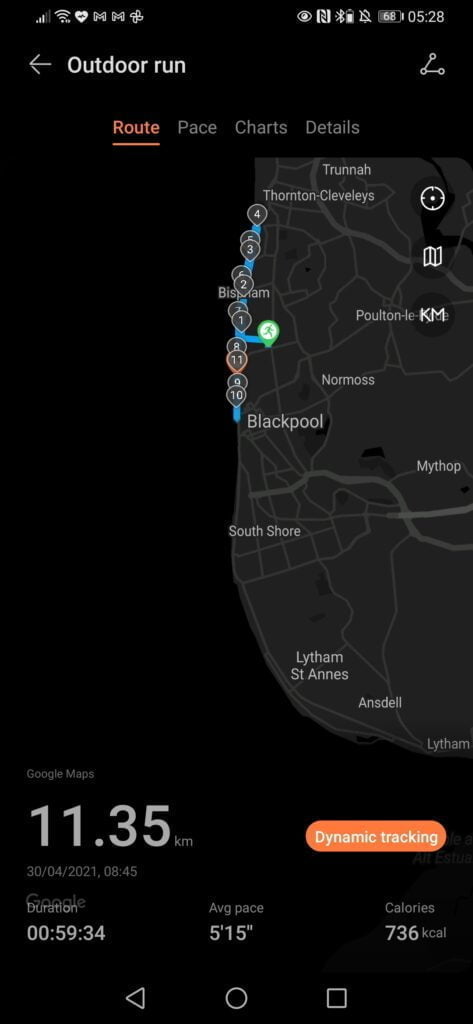
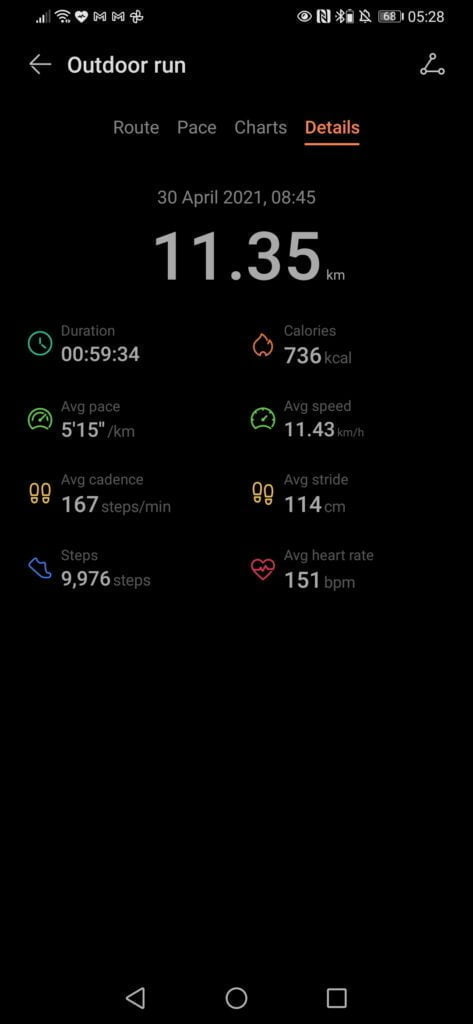
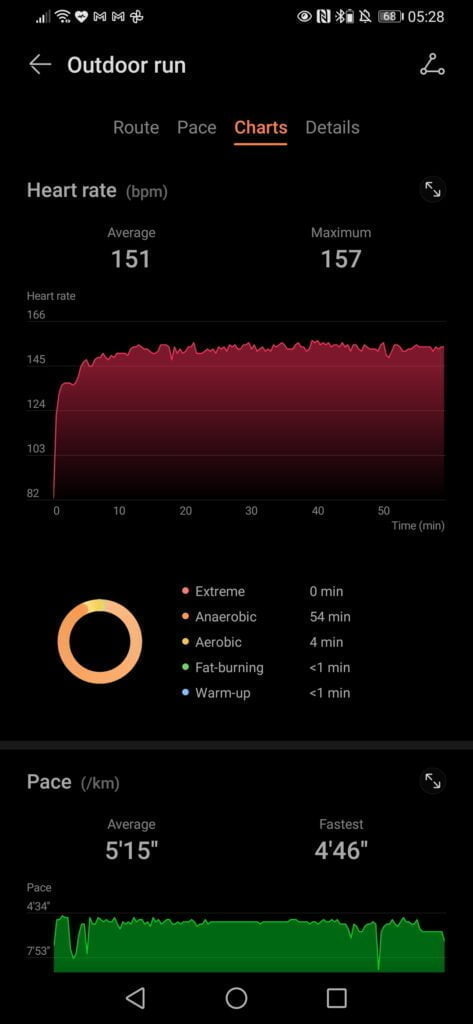
Due to marathon training and a knee issue, I haven’t had the chance to go for an outdoor bike ride while using the Honor Band yet, but I will update this post if I do.
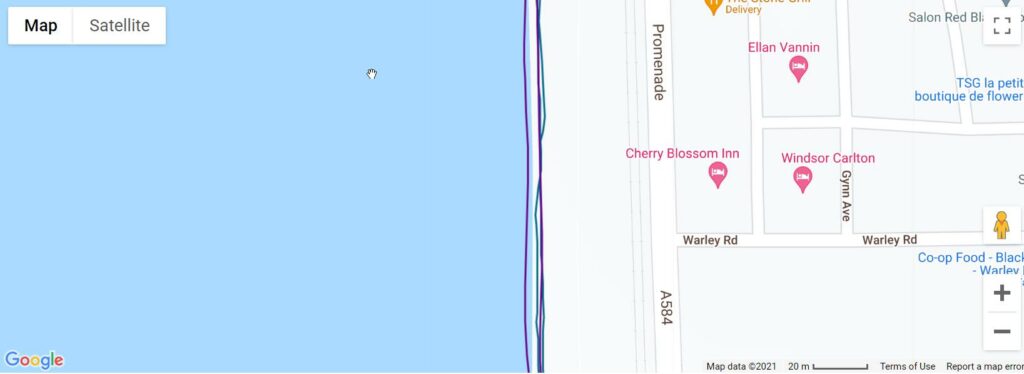
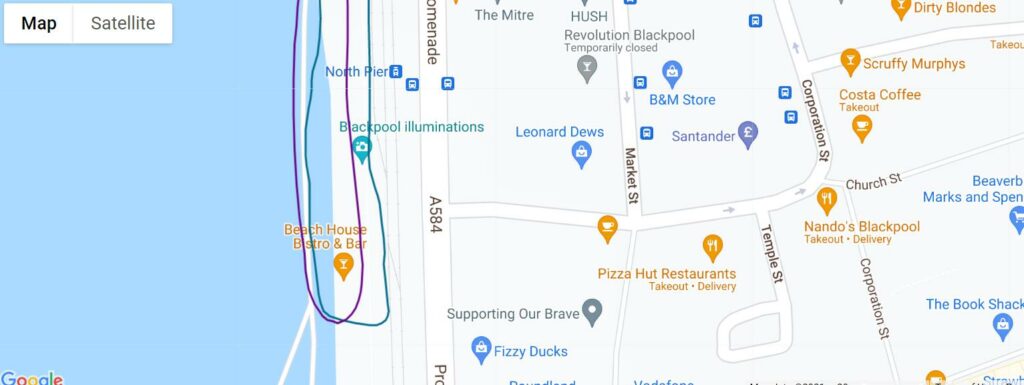
The band connects to the phone GPS quite fast, and I haven’t noticed any significant dropouts. GPS accuracy seems to be close to my Garmin. Looking at the plotted map from the exported files shows the Honor tracking my running in the sea rather than the promenade more than Garmin but the overall distance is almost identical.
For running, it collects a decent amount of data for a cheap wearable. On top of the usual distance, pace, and calories, you get cadence and stride length. So you can possibly use this data to improve your form.

Cadence

Both the cadence and stride length appear to be highly accurate. I used Stryd on the Garmin Fenix 6 Pro, so the most accurate consumer solution you can use and cadence was identical, while stride length was just 1cm off. The one caveat is that the sampling rate seems to be far lower than Garmin.
Heart Rate
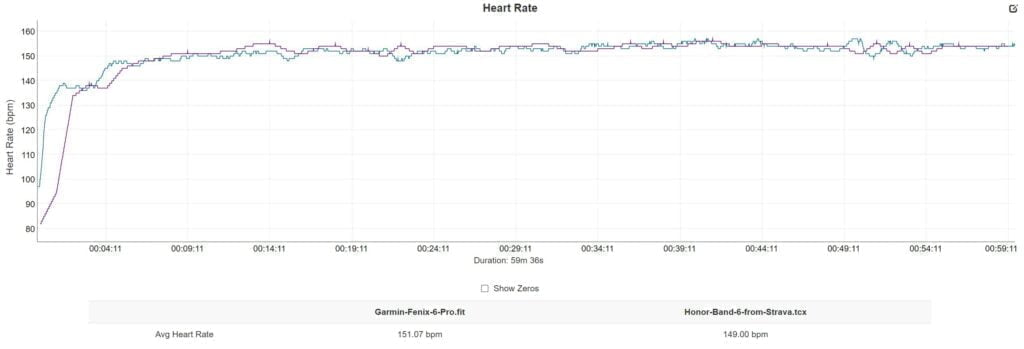
Heart rate accuracy is OK, better than some wrist-based heart rate solutions. There are no massive spikes or dips, so better than some solutions. Average HR seems to be around 2bpm off my Garmin chest strap, but the max HR is 5bpm off. Pretty good for a device this cheap. Similar to cadence, it looks like the sampling rate is much lower.
Even indoor cycling did OK. In a recent Zwift group ride, the Honor was 4bpm off, which looks to be caused by one big spike which went up to 173bpm vs 154bpm average and 164bpm max on my Garmin.
Of course, with wrist-based optical heart rate monitoring, it is essential you have a decent fit; you want it a bit above your wrist joint, with a close fit. A poor fit will lead to highly inaccurate results.
Oddly, in the footnotes of the Honor Band 6 page, it states:
Outdoor cycling workout feature only supports HONOR devices with Magic UI 2.0 and later or iOS devices with iOS 9.0 and later. When connecting to other devices, HONOR Band 6 will not display outdoor cycling.
It does, however, offer outdoor cycling as an option for me on my Huawei P30 Pro.
Sleep Tracking
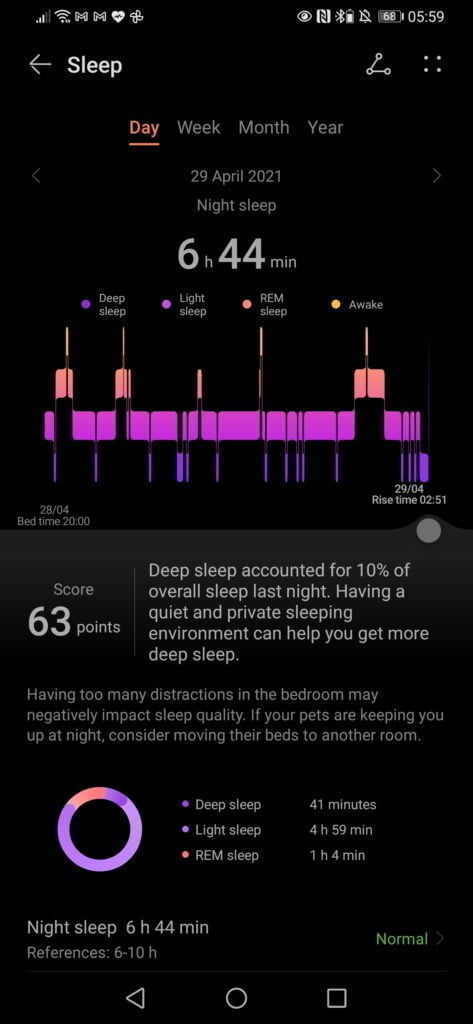
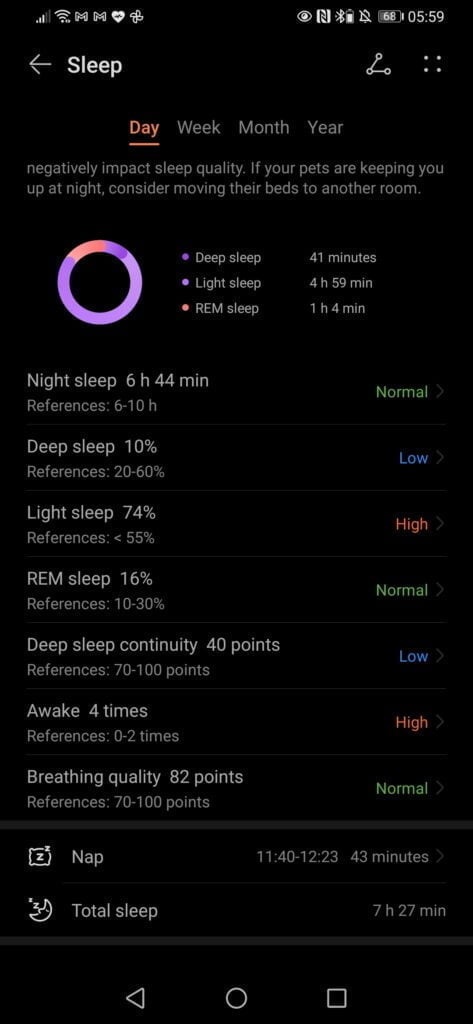
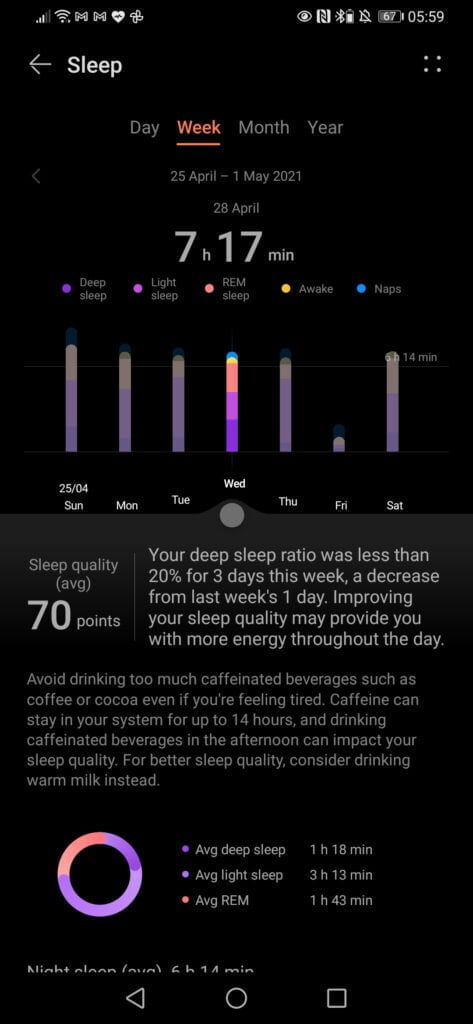
I have always found Huawei/Honor better than my Garmin for sleep tracking, but there is a caveat to this.
The Honor Band 6 seems to accurately track my sleep getting the times roughly correct, and it looks like it identifies when I way up correctly.
However, I am a bit of a freak with my sleep; I’m normally in bed at 7:30 pm and get up at 3 am. My brain doesn’t like me, and that’s the time it has chosen for my sleep routine. I stick to that routine 7 days a week, and I am a big believer in the circadian rhythm and the need to maintain a regular sleep cycle. Every Huawei/Honor device I have used has me going to bed at 8 pm. I am not sure if this is hardcoded for sleep tracking to start or if the watch has just identified this as my usual sleep cycle.
The analysis of my sleep seems to be more accurate than Garmin (which costs over 10x more in the case of the Fenix 6 Pro). It informs me that my light sleep is too much, my deep sleep continuity is poor, and I wake up too much. That is about the most accurate description of my sleep throughout my life you can get.
Battery Life
The main reason I have loved all the Honor and Huawei devices is the incredible battery life. They put Garmin to shame, and I can safely say I have no intention of ever owning a WearOS device until Qualcomm/Google pull their finger out and improve battery efficiency.
This is rated for two weeks of regular/normal use. This seems to be accurate; I probably track a lot more activities than normal people, between 1 hour and 2 hours per day, and the watch is still going strong after 9 days of use with around 35% left. I think I have charged my Garmin Fenix 6 Pro twice in this time.
Stress & All-Day Heart Rate
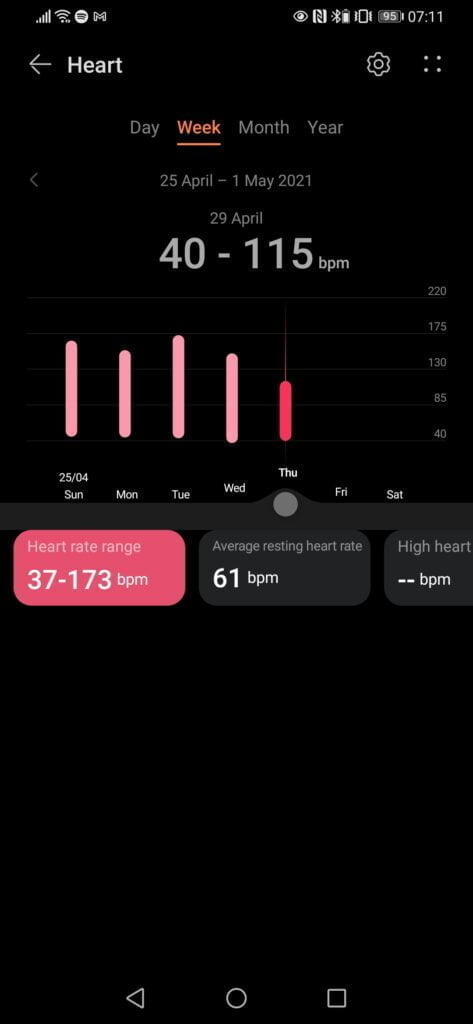
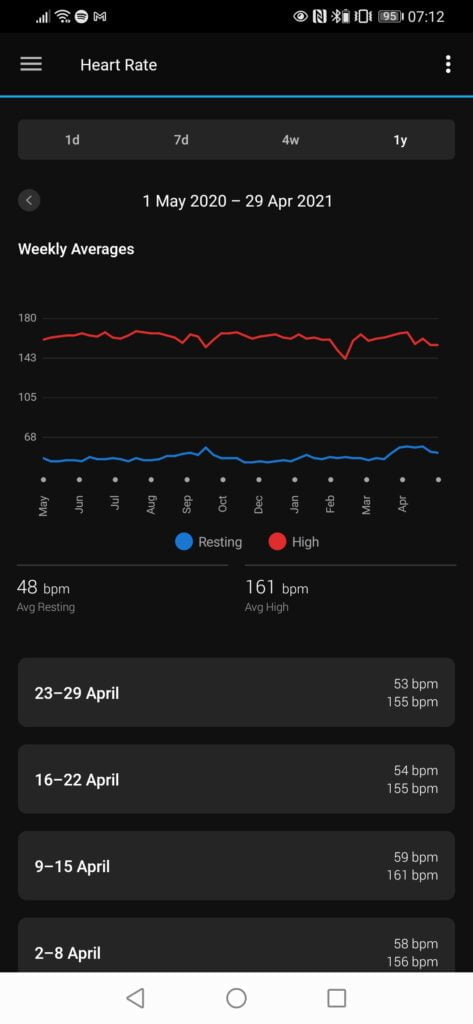
Both stress and all-day heart rate work as expected.
Huawei Health seems to calculate things differently than other devices. For your heart rate, it gives a range then resting heart rate. The low reading is always lower than the RHR, this is likely because your sleeping heart rate is lower, but I have found low readings throughout the day are also lower than the RHR.
Garmin is equally confusing; I have often looked at the current HR on my watch, and it is lower than what is being reported as my RHR. Garmin does generally report lower readings than Huawei Health, which for me is 48bpm vs 57bpm.
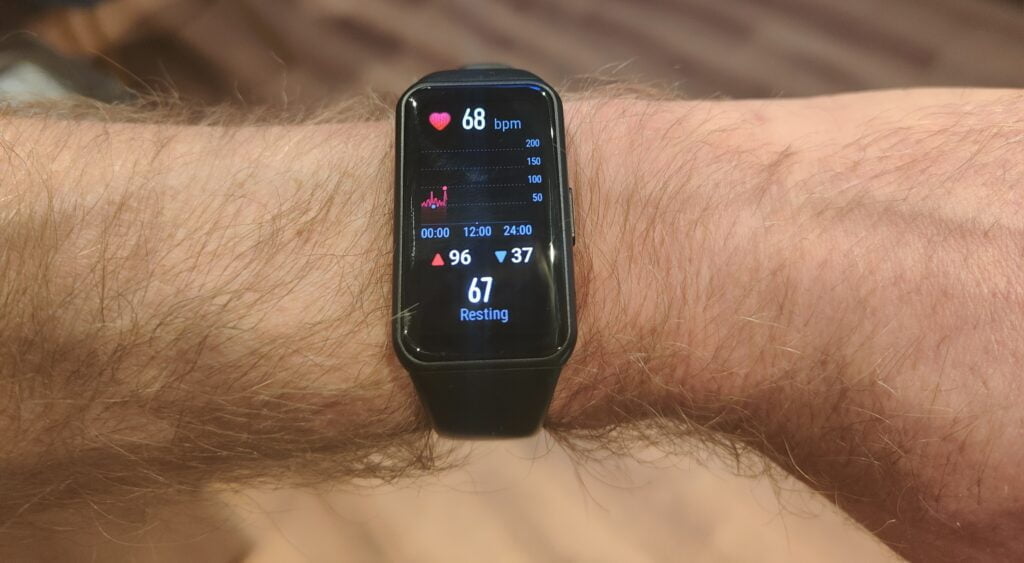
However, as long as it is healthy, I don’t suppose either interpretation of RHR matters too much.
Stress levels are also interpreted differently. Huawei Health has me well into the middle range of stress averaged out for the day, whereas Garmin thinks I am much more chilled out. I am not sure how accurate either is; subjectively, I’d say somewhere in the middle of the two readings.
SPO2
This is basically identical to the previous devices. It is one of them things you test a few times, get a good result for and don’t bother again. If you have low blood oxygen levels, there is a good chance you already know about it.
There are a couple of exceptions here, low blood oxygen can indicate sleep apnoea, but Honor doesn’t track it 24/7, so no use for that (they do track breathing, though).
It is theoretically possible to use SPo2 to diagnose COVID. It is one of the diagnostic criteria for use in a hospital, after all. So, in theory, if you have symptoms, you could test it, and if you have a low oxygen level, it is probably worth dialling 111 and asking for some medical advice.
Other Features – Notifications
Beyond fitness tracking or just checking the time, the only thing I use wearables for is notifications from my phone, which I absolutely love, because my phone is mostly on silent/vibrate.
You can select what apps you want or don’t want to bother you. So, for me, I keep things as minimal as possible, mainly just messaging apps (Telegram/WhatsApp) as well as my Arlo video doorbell.
Music control works well, too, but 9 times out of 10, I find it easier just to get my phone out to change a track (mainly because I’ll change the playlist rather than skip a track).
There is also a remote shutter function; this is another thing that Honor state is only supported on Honor devices with Magic UI 2.0 and later, but works on my P30 Pro. It is not something I have used much, but with the prospect of travelling on the horizon it could be a handy feature.
Price and Alternative Options
The Honor Band 6 is £44.99 from Amazon
The previous Honor Band 5 is £35.99 with the option for 10% off. Personally, I think the extra tenner or so is well worth it for the larger display and more attractive design. However, the size of the Band 6 is pushing smartwatch territory, and if it is a band you want, then the Band 5 is an excellent choice.
The Huawei Band 6 appears to be almost identical, perhaps a superior build/design (I haven’t seen it in real life), and it costs £59.99
The Huawei Band 4 Pro, has built-in GPS and is just £49.00. It has a smaller display (similar to the Honor Band 4), but the built-in GPS will be an excellent option for anyone wanting to track outdoor activities.
The Huawei Watch Fit is the option I’d go for if you want an upgrade, the display is even bigger, so this is full-on smartwatch sized. It has built-in GPS and costs just £79.95
There is also the Xiaomi Mi Band 6 or Band 5; both offer very similar features to the Honor, just with the Xiaomi ecosystem instead. Personally, I think the Mi Band 6 looks a little ugly vs the Honor.
Overall
The Honor Band 6 is excellent, at under £45, it is hard to criticise much about devices like these.
It is quite a large 25% price hike vs the Honor Band 5, but that £10 is worth it for the larger display.
Overall, the Honor Band 6 continues the tradition of the Honor Bands being one of the best choices for anyone wanting an affordable way to get into fitness tracking and smart wearables.
Honor Band 6 Review Rating
Summary
Not much has changed since the last generation, but the new larger higher resolution display is a big improvement. This is still one of the best options for someone looking for an affordable fitness tracker.
Overall
85%-
Overall - 85%85%
Pros
- Nicer design than the Honor Band 5
- Much larger display is easier to use
- Excellent value for money
Cons
- 25% more expensive than Honor Band 5
I am James, a UK-based tech enthusiast and the Editor and Owner of Mighty Gadget, which I’ve proudly run since 2007. Passionate about all things technology, my expertise spans from computers and networking to mobile, wearables, and smart home devices.
As a fitness fanatic who loves running and cycling, I also have a keen interest in fitness-related technology, and I take every opportunity to cover this niche on my blog. My diverse interests allow me to bring a unique perspective to tech blogging, merging lifestyle, fitness, and the latest tech trends.
In my academic pursuits, I earned a BSc in Information Systems Design from UCLAN, before advancing my learning with a Master’s Degree in Computing. This advanced study also included Cisco CCNA accreditation, further demonstrating my commitment to understanding and staying ahead of the technology curve.
I’m proud to share that Vuelio has consistently ranked Mighty Gadget as one of the top technology blogs in the UK. With my dedication to technology and drive to share my insights, I aim to continue providing my readers with engaging and informative content.
Last update on 2025-07-12 / Affiliate links / Images from Amazon Product Advertising API

